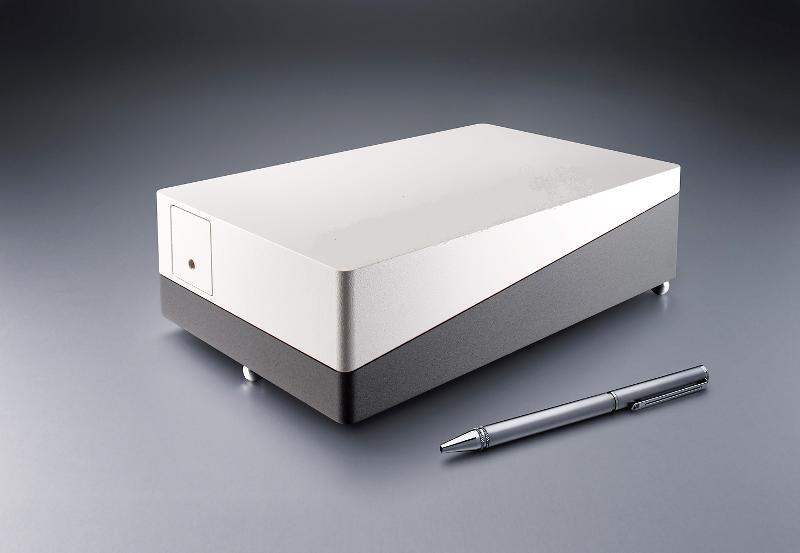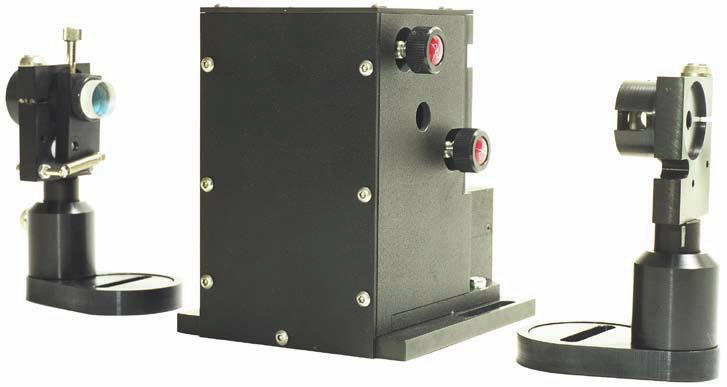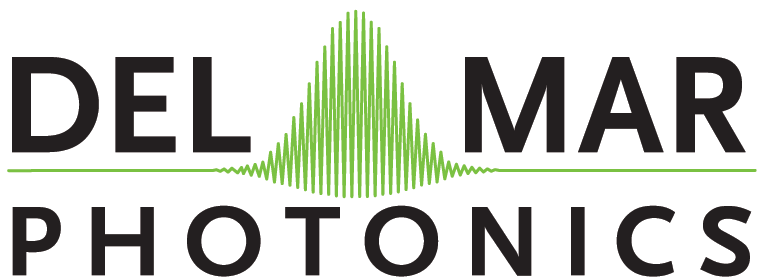
Variable Attenuators for Femtosecond Ti:Sapphire Lasers
Diffractive attenuators control the power
of laser radiation using diffraction gratings. Since phase diffraction gratings
do not absorb light they can be used for high-power laser radiation (cw,
pulsed). Variation of grating parameters along the substrate results in variable
transmission at a given wavelength.
Diffractive attenuators can be designed for wavelength from deep UV till IR for
laser powers up to 250W/cm2 in CW and 1000mJ/cm2 in 10ns
pulses.
Principle of operation
Light beam passing through a diffractive grating is partially deflected into several diffractive orders, which get subsequently blocked by diaphragm. Thus the zero order beam (does not change the direction of propagation) is attenuated. The intensity of output radiation Ioutput depends on the grating design and wavelength of input beam. By changing the grating parameters one can control the power of output radiation1. The transmission coefficient of such an attenuator is h = Ioutput/Iinput..
Design of diffractive attenuator on the base of circular diffractive grating.

Key features
Applications
Attenuator design

Specifications
|
Substrate material - surface flatness - wedge - outside-, inside diameter - thickness - clear aperture Design wavelength Transmission range Transmission function Deviation from linearity of transmission Polarization Coating S1, S2 Damage threshold Cleaning |
UV grade fused silica l/4 @ 532nm over clear aperture <20 arcsec 60 mm, 8mm 4 mm 10 mm 532nm, 800nm, 1064nm (others wavelengths on request) T = 0.01 (0.025) – 0.95 ± 5% over 340o linear (approximated by stair case with 20 steps) <5% Transmission not dependent on polarization Broadband antireflection coating, R532/1064<0.3% 250 W/cm2 -CW, 1000 mJ/cm2 with 10ns pulses Non-abrasive method, acetone or isopropyl alcohol |
Diffractive attenuator with mount

|
||||||
|
|
||||||
|
||||||
Diffractive Variable Attenuator (DVA) -
buy online
Diffractive Variable Attenuator Housing
-
DVA picture
Variable Attenuators for Femtosecond Ti:Sapphire Lasers
Diffractive variable attenuators for
femtosecond lasers
Diffractive Variable Attenuator for High Power Lasers -
DVA-800nm
Circular Laser Writing Systems CLWS-300/C and
CLWS-200
 |
Trestles LH Ti:Sapphire
laser Trestles LH is a new series of high quality femtosecond Ti:Sapphire lasers for applications in scientific research, biological imaging, life sciences and precision material processing. Trestles LH includes integrated sealed, turn-key, cost-effective, diode-pumped solid-state (DPSS). Trestles LH lasers offer the most attractive pricing on the market combined with excellent performance and reliability. DPSS LH is a state-of-the-art laser designed for today’s applications. It combines superb performance and tremendous value for today’s market and has numerous advantages over all other DPSS lasers suitable for Ti:Sapphire pumping. Trestles LH can be customized to fit customer requirements and budget. Trestles LH plus OPO (Optical Parametric Oscillator)
Reserve a
spot in our Femtosecond lasers training
workshop in San Diego, California. Come to learn how to build a
femtosecond laser from a kit |
 |
DPSS DMPLH lasers |
 |
Pismo pulse picker The Pismo pulse picker systems is as a pulse gating system that lets single pulses or group of subsequent pulses from a femtosecond or picosecond pulse train pass through the system, and stops other radiation. The system is perfectly suitable for most commercial femtosecond oscillators and amplifiers. The system can pick either single pulses, shoot bursts (patterns of single pulses) or pick group of subsequent pulses (wider square-shaped HV pulse modification). HV pulse duration (i.e. gate open time) is 10 ns in the default Pismo 8/1 model, but can be customized from 3 to 1250 ns upon request or made variable. The frequency of the picked pulses starts with single shot to 1 kHz for the basic model, and goes up to 100 kHz for the most advanced one. The Pockels cell is supplied with a control unit that is capable of synching to the optical pulse train via a built-in photodetector unit, while electric trigger signal is also accepted. Two additional delay channels are available for synching of other equipment to the pulse picker operation. Moreover, USB connectivity and LabView-compatible drivers save a great deal of your time on storing and recalling presets, and setting up some automated experimental setups. One control unit is capable of driving of up to 3 Pockels cells, and this comes handy in complex setups or contrast-improving schemes. The system can also be modified to supply two HV pulses to one Pockels cell unit, making it a 2-channel pulse picker system. This may be essential for injection/ejection purposes when building a regenerative or multipass amplifier system. |

Del Mar Photonics, Inc.
4119 Twilight Ridge
San Diego, CA 92130
tel: (858) 876-3133
fax: (858) 630-2376
Skype: delmarphotonics
sales@dmphotonics.com